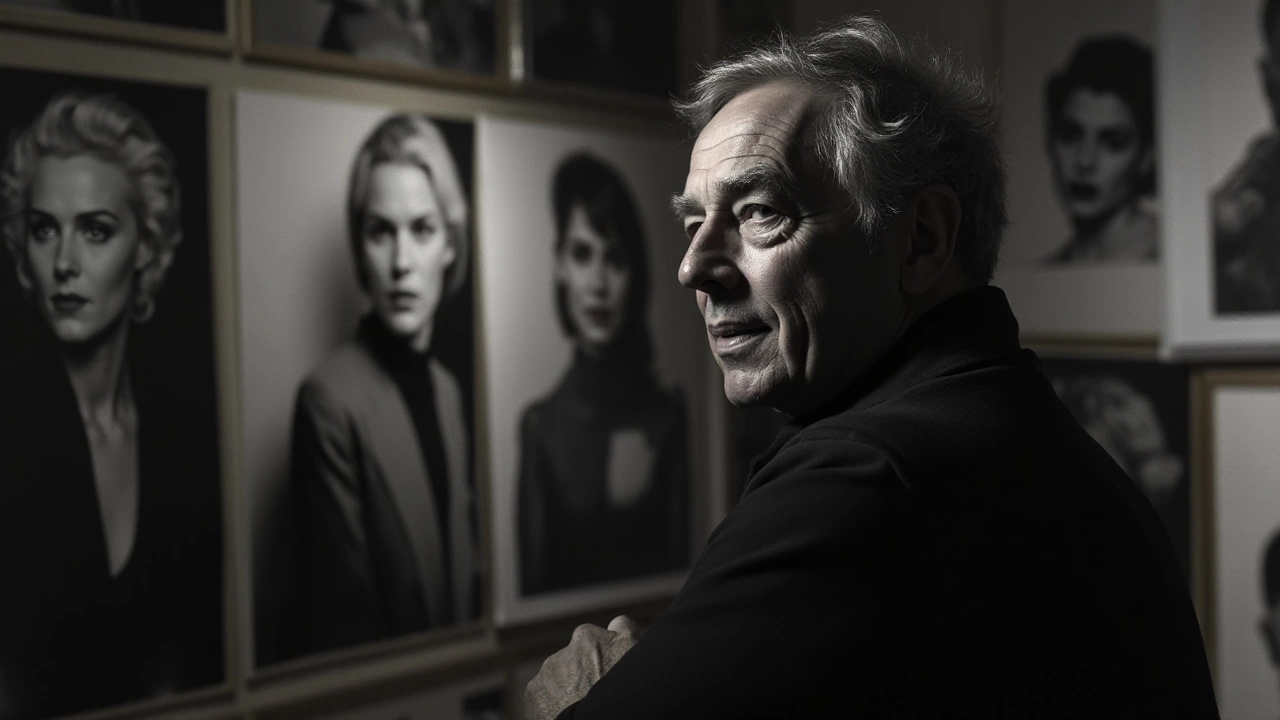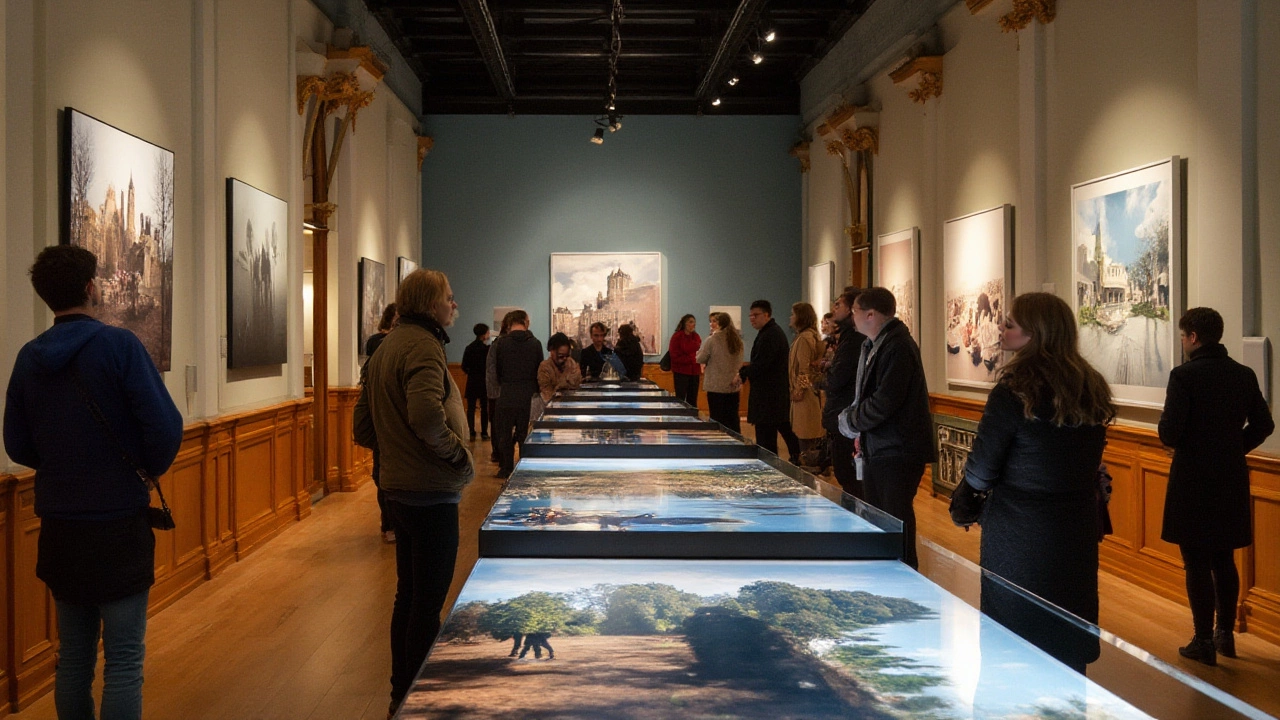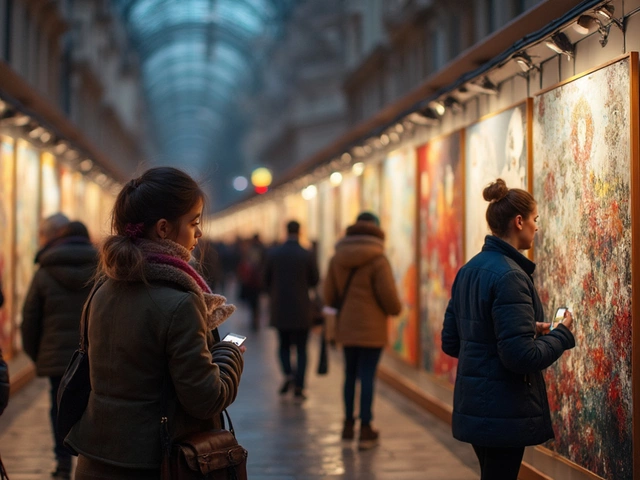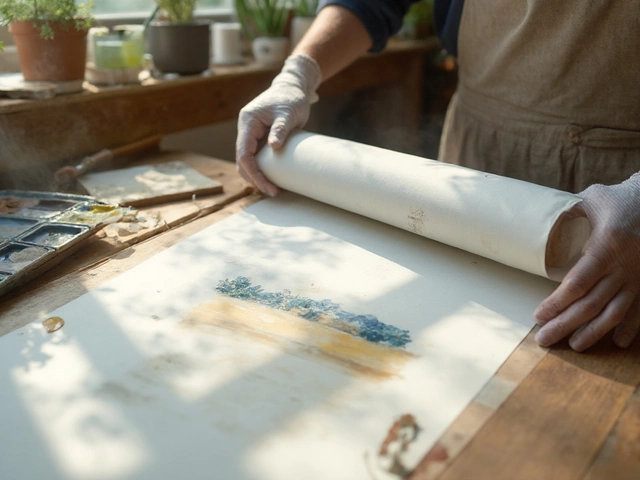Photography has gifted us moments we might otherwise have never been able to experience firsthand. It holds the power to freeze moments in time, forever capturing the essence of both ordinary and extraordinary events. Some photographers have stood out not only for their technical prowess but for their unique ability to tell stories through their images.
In this exploration of notable figures in fine art photography, we take a closer look at those who have left an indelible mark on the craft. Each photographer featured has contributed to shaping the way we perceive and interpret the world, using their lenses to offer insights deeply personal yet universally resonant. Let's embark on a journey through the life and work of some iconic photographers whose names have echoed through time.
- Ansel Adams: Master of Landscapes
- Diane Arbus: A New Perspective
- Richard Avedon: Redefining Portraiture
- Henri Cartier-Bresson: Moments in Time
- Annie Leibovitz: The Celebrity Lens
Ansel Adams: Master of Landscapes
Ansel Adams remains an iconic figure in the realm of fine art photography, celebrated for his compelling black-and-white landscapes that captured the vastness and beauty of America's natural heritage. Born in San Francisco on February 20, 1902, Adams' early fascination with nature was kindled by family trips to Yosemite National Park. These experiences laid the groundwork for a lifelong dedication to capturing the majesty of wild places with his camera. Adams’ work was characterized by meticulous attention to detail and a visionary approach, allowing him to portray a version of nature that was nothing short of breathtaking.
His photographic journey truly began when he was gifted a Kodak Brownie camera on one of those formative trips to Yosemite. Adams' commitment to his craft was evident in the painstaking way he developed his prints, achieving an unparalleled clarity and depth. He is perhaps best known for his development of the "Zone System," a technique for properly exposing and developing film to capture a precise balance of shadows and highlights. This method became a staple among serious photographers who sought to emulate the striking effects that Adams regularly achieved in his images. Ansel Adams was not simply a photographer; he was an artist with a deep connection to his subject matter. He felt a profound sense of stewardship for the landscapes he immortalized, which was evident in his numerous conservation efforts. Many have noted that his work inspired greater environmental awareness and appreciation for national parks in the United States.
Notable Works and Techniques
Among Adams' extensive portfolio, certain photographs have achieved legendary status. His image "Moonrise, Hernandez, New Mexico" is one such masterpiece, capturing a dramatic twilight over a village cemetery with the moon and snow-capped mountains in the distance. This photograph epitomizes Adams' ability to poeticize the natural world through his lens. It is often said that he captured the shots not just with his eyes but with his heart, earning him widespread acclaim and admiration.
But what made Adams' pictures stand out was not only his technique or equipment but his timing and perception of light. An understanding of when to press the shutter was tantamount to genius. “Photography is more than a medium for factual communication of ideas. It is a creative art," Adams once stated. His profound victory was in demonstrating that the outdoor world could be viewed through a new aesthetic lens—where sky, earth, and life converged into an experience far richer than the sum of its parts.
In the world of photography, Ansel Adams' contribution remains invaluable, not only for his remarkable imagery but also for his role as a staunch advocate of the preservation of natural spaces, forever connecting art with action.
Adams' influence persists, with photographers around the globe striving to emulate his approach to capturing nature. Through his work, he has inspired countless individuals to view the world through a conservation lens, understanding the value of what lies in front of them not just as an image, but as a legacy to be preserved. This enduring legacy continues to shape the field of fine art photography and to inform the practices of emerging famous photographers.
Diane Arbus: A New Perspective
Diane Arbus is a name synonymous with the exploration of human oddity and complexity through the lens. In an era when photography often aimed to capture beauty and perfection, Arbus instead turned her camera towards subjects who were considered outcasts by the standards of conventional life. Born in 1923 in New York City, she grew into a society built on appearances. It was exactly this environment that Diane chose to scrutinize and peel back, to reveal the layers of human vulnerability beneath the facade. Her work often featured individuals from the fringes of society: dwarfs, giants, transgender people, circus performers, and everyday New Yorkers in stark, unflinching clarity.
The Early Influences
Arbus's background played a significant role in shaping her unique perspective. Growing up in an affluent family, she was first introduced to photography by her husband Allan Arbus, with whom she broke into fashion photography. But fashion's glamorous allure soon wore thin for Diane. Her turning point came when she met Lisette Model, a photographer known for her bold portraits, who became her mentor. It was under her guidance that Arbus embraced the kind of disquieting imagery that would later define her career. This shift marked a profound transformation in her style, as she began venturing into her own, often unsettling vision of the world."A photograph is a secret about a secret. The more it tells you, the less you know." — Diane Arbus
Capturing the Unseen
Arbus's photographs were often laden with psychological weight. They captured moments that transcended superficial judgments and delved into the core of her subjects' identities. One of her most famous series, "Identical Twins, Roselle, New Jersey," portrays two young girls, standing side by side, eerily identical yet subtly different upon closer inspection. Such compositions challenged viewers to confront their preconceptions and the eerie discomfort of looking too closely. The world she portrayed wasn't an alternate reality but a direct reflection—albeit a less acknowledged one—of the diversity existing in everyday life. It was her aim, it seems, to democratize the attention we give to people's stories, breaking away from the archetypes glorified in mainstream media.Legacy and Impact
Arbus's influence on photography is profound, extending far beyond her own lifetime. Her commitment to diving into the realities of life's perceived 'outsiders' carved a niche that many photographers find inspiration in today. She has challenged them to look beyond perfection in search of stories that resonate with authenticity and truth. Her work stirs strong emotional reactions, prompting discussions about ethics, privacy, and consent in art. It's a testimony to her powerful presence in fine art photography that her work remains both controversial and celebrated decades after her passing.
Richard Avedon: Redefining Portraiture
Richard Avedon's journey into the world of photography began amid the bustling streets of New York City, where he was born in 1923. As a young man, Avedon served in the Merchant Marine, where he honed his skills photographing identity portraits of sailors. His keen eye and ability to capture the essence of his subjects soon led him to work with some of the most eminent magazines of the time, including Harper's Bazaar and Vogue. It's no exaggeration to say that Avedon transformed portrait photography, bringing a fresh and dynamic approach that differed vastly from traditional techniques.
Avedon had a knack for creating exceptionally crisp and stark images that brought out the character in his subjects. His stark white background setup in studio photography allowed every detail to pop; it was innovative and daring in an era where elaborate settings dominated. This trademark simplicity drew attention directly to the sitter's personality, stripping away distractions. Through this method, Avedon's work conveyed more than mere appearances; it delved into emotions and inner complexities.
"A portrait is not a likeness. The moment an emotion or fact is transformed into a photograph it is no longer a fact but an opinion," Avedon once asserted in an interview, highlighting his belief that photos should be more interpretive and subjective.
Beyond magazine spreads, Avedon's bold perspectives in photography also reached gallery walls. He garnered acclaim in both commercial and fine art circles, orchestrating exhibitions like 'The Family,' a fascinating tableau of influential Americans captured in the 1970s. In this series, Avedon presented political icons, corporate tycoons, and cultural figures in raw, unfiltered portrayals. Such compositions dared to present these powerful personas devoid of the pomp and careful curation they often surrounded themselves with, hence inviting the viewer into a more intimate, albeit sometimes stark, gaze.
Moreover, Avedon's contributions extended into the domain of fine art photography. His portrayals of the American West for 'In the American West' remain extraordinary, capturing working-class individuals with intense honesty and dignity. These images contrasted sharply with his glamorous fashion photography, yet shared the same intent of revealing deeper truths about the subjects. In crafting these portraits, Avedon exemplified his philosophy that capturing a person's experience and personality was integral, even more so than capturing their photographic 'image.' There's a powerful statistical note to consider: his exhibition 'Richard Avedon: Portraits' became one of the most visited photography showcases in the Modern Art Museum of Fort Worth's history, illustrating his profound impact on contemporary photography.
Henri Cartier-Bresson: Moments in Time
Henri Cartier-Bresson, often hailed as the father of modern photojournalism, established an unparalleled blueprint for capturing candid photography with his philosophy of the "decisive moment." Born in 1908 in Chanteloup-en-Brie, France, Cartier-Bresson's journey into the world of photography began after his early attempts as a painter. His transition was profoundly influenced by photography's potential to document life as it unfolded, something he adopted with his extraordinary technique and keen eye for composition.
In a career spanning several decades, Cartier-Bresson traversed the globe, his camera capturing snapshots that transcended ordinary storytelling. He co-founded Magnum Photos in 1947, a pioneering cooperative agency that gave photographers unprecedented rights over their images. Armed with his trusty Leica, he preferred to remain unobtrusive, capturing people in a way that was both truthful and poetic. His oeuvre includes some of the most iconic images of the 20th century, like the debut of Pablo Picasso's rare studies and the funeral of Mahatma Gandhi. These images documented humanity in its purest form, unguarded moments that echo with authenticity and emotion.
Cartier-Bresson's work isn’t merely the documentation of history; it’s an exploration of the human condition through a lens. His 1952 book "Images à la Sauvette" or "The Decisive Moment" served as a manifesto of his photographic philosophy and remains a seminal work in avant-garde photography.
“To me, photography is the simultaneous recognition, in a fraction of a second, of the significance of an event.” — Henri Cartier-BressonThis statement captures his essence, presenting photography as both an art and a science devoted to time and presence.
Cartier-Bresson believed photography taught him patience, the art of waiting for the right moment when human expression merged with the perfect geometry of the scene. His framing was meticulous, removing the need for cropping. He was an advocate of natural light and refrained from using flash, placing emphasis on modesty and respect for the subject. His approach influenced how photographers perceived reality and documented it, establishing a legacy that redefined notions of photography.
The impact of Cartier-Bresson’s work extends beyond the visual, exploring social, political, and cultural nuances through his lens. His contribution paved the way for generations of photographers who pursued truth in visual storytelling. His images don’t just attract with their aesthetic allure; they provoke, enlighten, and evoke a deep emotional connection. In a world full of staged and edited images, Henri Cartier-Bresson's work remains a masterclass in authentic, purely captured moments, reminding us of the power inherent in simplicity and spontaneity.

Annie Leibovitz: The Celebrity Lens
Annie Leibovitz has become synonymous with iconic photography that encapsulates the spirit and personality of her subjects. Her journey began in the late 1960s when she joined Rolling Stone magazine as a staff photographer. It was a time when the music scene was exploding with energy and dynamic figures, providing the perfect canvas for Leibovitz’s innovative style. Her distinct ability to capture the essence of celebrities helped elevate her status within the industry, marking the beginning of a remarkable career.
Leibovitz’s method involves meticulous preparation and a keen understanding of both the subject and the story they wish to convey, which allows her to produce famous portraits that seem to come alive with expression. One of her most celebrated works is the photograph of John Lennon and Yoko Ono, shot just hours before Lennon’s tragic death in 1980. The image, filled with vulnerability and love, illustrates how Leibovitz goes beyond merely capturing faces; she crafts narratives that resonate with viewers on a deep emotional level. Her talent lies in her capacity to make people comfortable, allowing their true selves to emerge.
With bold compositions and a passion for storytelling, Leibovitz has worked with publications like Vanity Fair and Vogue, where her photographs often became talking points themselves. Her portraits range from political figures to pop culture icons, with images such as the shot of Whoopi Goldberg immersed in milk and the breathtaking portrait of Queen Elizabeth II proving her versatility. She knows no boundaries when it comes to the breadth of her subjects, offering a wealth of diversity that adds to her status as a trailblazing figure in fine art photography.
Once, in a discussion about her approach to celebrity photography, Leibovitz mentioned,
"In a portrait, you always leave room for the subject; you invite a conversation.”This philosophy is evident across her portfolio, where each image reflects a mutual understanding and collaboration between the photographer and the celebrity. Her work is less about merely capturing a face and more about exploring a narrative. Each photograph stands as part of a larger story, illustrating the complexities and nuances of its subject.
Beyond the celebrity sphere, Annie Leibovitz has also ventured into personal projects and has published numerous collections of her work, such as the comprehensive volume "Annie Leibovitz: A Photographer’s Life, 1990–2005," which offers insight into both her professional achievements and personal journey. Her exhibitions draw crowds worldwide, testament to her enduring impact on the photography world. For young photographers seeking inspiration, Leibovitz’s career exemplifies how passion and perseverance can transform raw talent into historic art.





